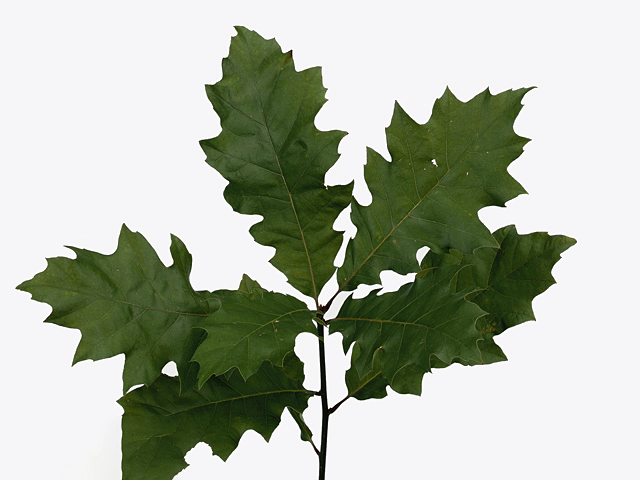Quercus rubra

| Leaf arrangement | spreaded |
| Life span | Long (over 200 years) |
| Fruit type | Nut(let) |
| Leaf margin | Lobed |
| Leaf type | Foliage leaf |
| Winter hardness | Good (USDA-zone 5, 6) |
| Soil fertility | Not very demanding |
| Leaf, general shape | Elliptic / oval |
| Inflorescence | Catkin |
| Leaf duration | Deciduous |
| Light conditions | Semi-shades; Sunny |
| Growth rate | Normal; Fast |
| Leaf division | Simple |
| Plant, growth type | Erect |
| Flower sex (distribution) | Monoecious (flowers unisexual) |
| Leaf, main color | Red; Medium brown |
| Application / Suitable for | Solitary plant; Avenue tree; Park tree; Street tree; Landscape |
| Sensibilité au sel d'épandage | Tolerant |
| Fruit-bearing period (notable) | Late summer (September) |
| Fruit color (notable) | Green |
| Autumn color (notable) | Red |
| Toxicity (if consumed) | Not or barely |
| Moisture requirements | Dry |
The majestic Quercus rubra, commonly known as the Red Oak, is a species of oak tree that boasts impressive features and characteristics. This long-lived tree can thrive for over 200 years, making it a symbol of strength and endurance.
The Red Oak has a spreaded leaf arrangement, with foliage leaves that are lobed in their margin. The leaves themselves are elliptic/oval in shape, and during the autumn season, they turn a stunning shade of red, adding a vibrant burst of color to any landscape. However, during the summer months, the leaves display a medium brown hue.
This species of oak produces catkin inflorescences and has monoecious flowers, meaning that they bear both male and female flowers on the same tree. The Red Oak's fruit takes the form of nutlets, which are notable for their green color during late summer.
The Red Oak demonstrates good winter hardness, thriving in USDA hardiness zones 5 and 6. It can tolerate colder temperatures and is well-suited to areas with moderate to full sun exposure and semi-shaded conditions. This versatile tree has a normal to fast growth rate, easily adapting to various light conditions.
Regarding soil fertility, the Red Oak is not very demanding, making it suitable for a range of soil types. It can grow well in moderately fertile soils and is known for its ability to thrive in dry conditions. However, it's essential to ensure that the soil is well-drained to avoid any potential waterlogging issues.
The Red Oak is a popular choice for a variety of applications. It can be planted as a solitary tree, enhancing the beauty of a garden or landscape. Additionally, it is commonly used as an avenue tree, park tree, and street tree, adding a touch of elegance to urban environments. With its adaptability, this tree can flourish in a range of landscaping designs.
One notable feature of the Red Oak is its tolerance to salt spread, making it suitable for coastal areas or regions where salt is used for de-icing in winter. This attribute allows the tree to withstand the harmful effects of salt without compromising its health and vitality.
It's important to note that while the Red Oak is generally safe, its consumption should be avoided due to its barely existent toxicity, especially in animals and humans. As with any plant material, it's essential to exercise caution and prevent ingestion.
In conclusion, the Red Oak, scientifically known as Quercus rubra, is an impressive tree with its spreaded leaf arrangement, lobed leaves, and monoecious flowers. Its long life span, adaptability to various light and soil conditions, and resistance to salt spread make it a desirable choice for landscapes, parks, and streets. Not to mention, its vibrant autumn color and striking appearance make the Red Oak a sight to behold.
Market availability index by month:
| Jan. | Feb. | Mar. | Apr. | May | Jun. | Jul. | Aug. | Sep. | Oct. | Nov. | Dec. |
|---|---|---|---|---|---|---|---|---|---|---|---|
| 1 | 1 | 1 | 1 | 1 | 1 | 1 | 2 | 3 | 4 | 1 | 1 |